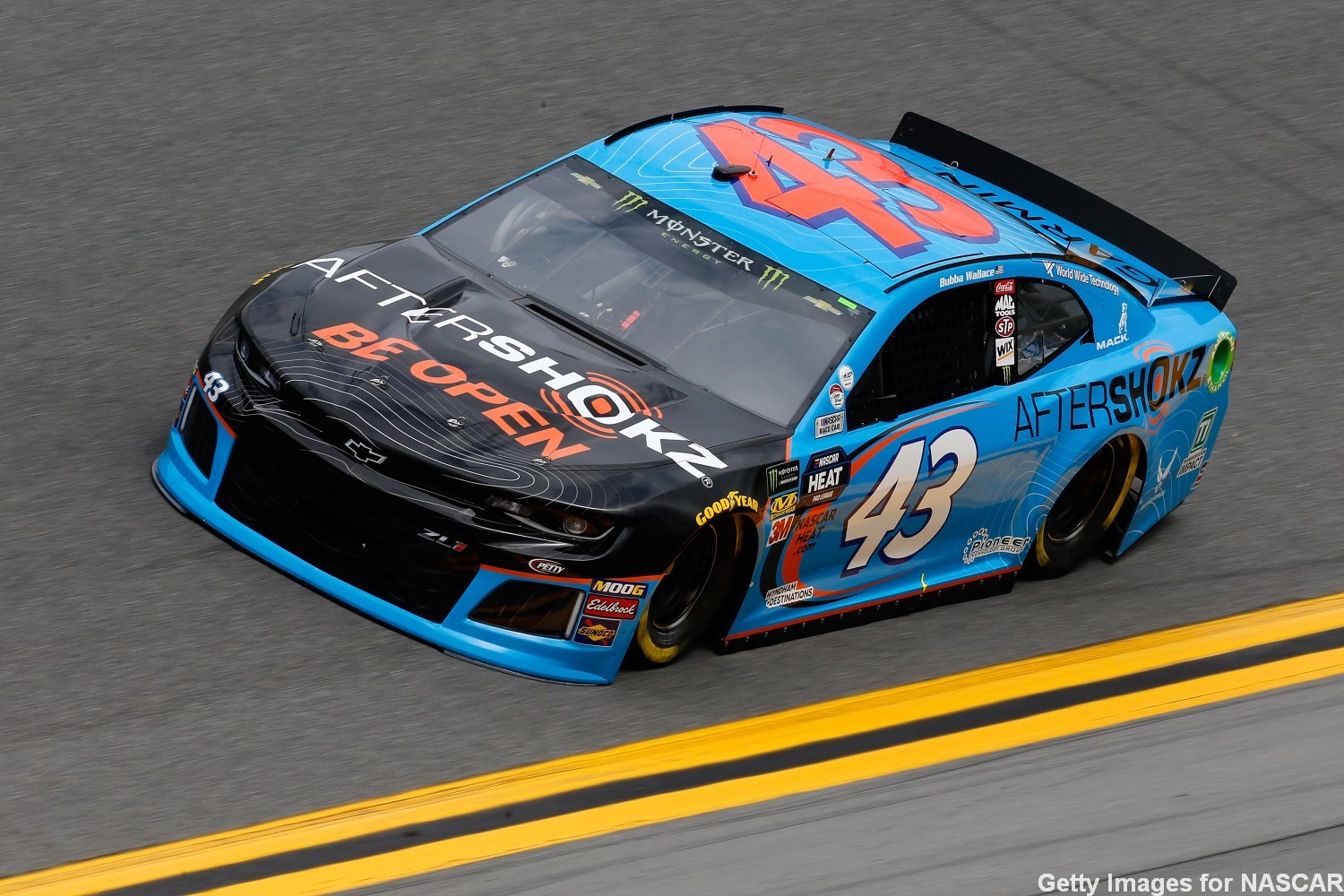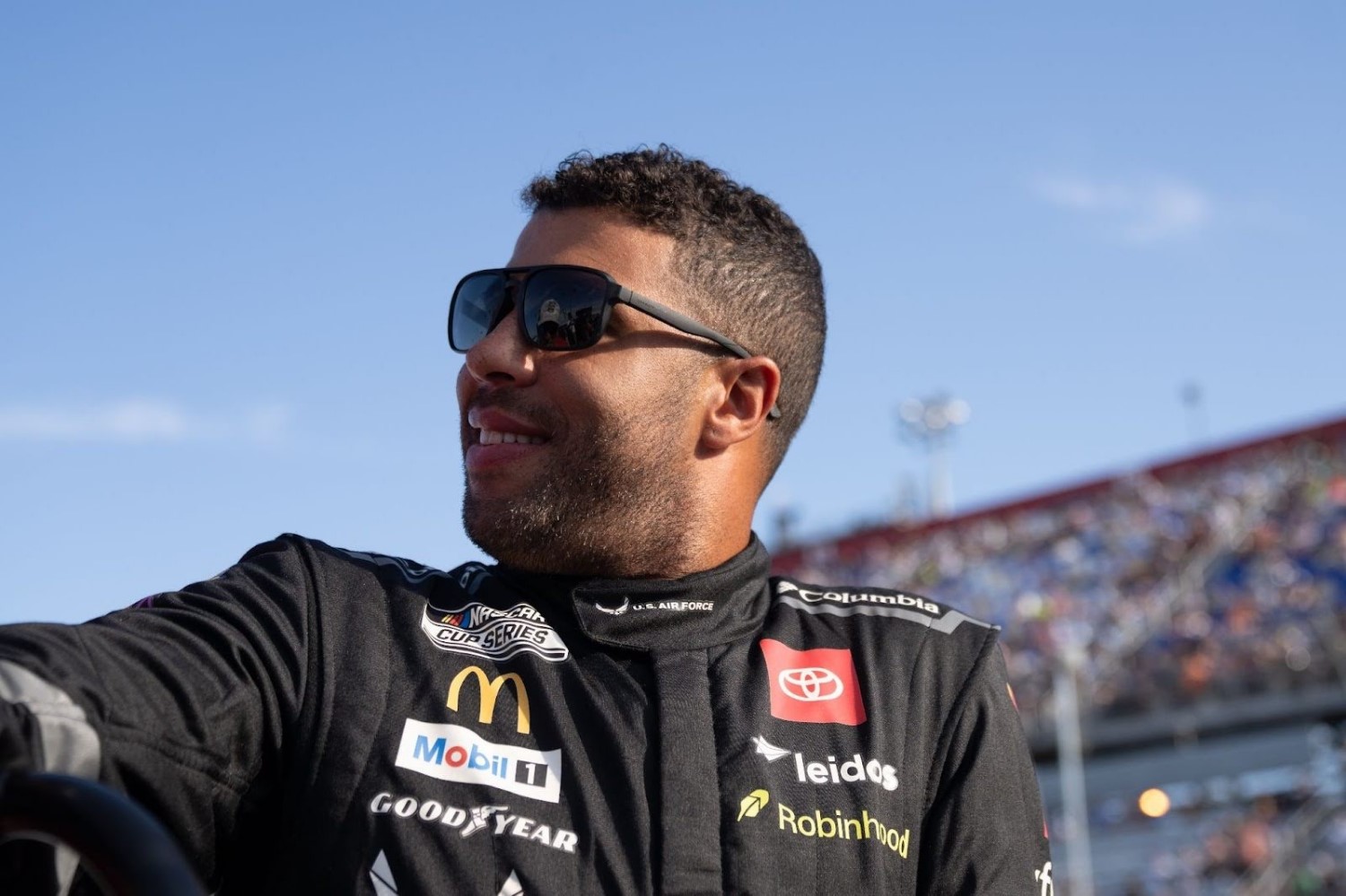NASCAR Rumor: Bubba Wallace intentionally spun out Stenhouse
The name Bubba Wallace (pictured) alone ignites fierce reactions from a vocal segment of NASCAR’s fanbase—a dynamic that’s as predictable as it is divisive. And while not every controversy is self-inflicted, Wallace has a track record of finding himself in the crosshairs, often with timing that raises eyebrows.
–by Mark Cipolloni–
That was the case again on Saturday night at Bristol Motor Speedway during the Bass Pro Shops Night Race. Wallace, already locked into the Round of 12 playoffs, had surged to the lead but tumbled to the mid-teens amid brutal Goodyear tire wear in the third stage.
Desperate for fresh rubber, he needed to pit—but pitting under green would’ve left him laps down. Moments before reaching pit road, he veered right, clipping the left rear of Ricky Stenhouse Jr.’s No. 47 Chevy and sending the non-playoff driver spinning into the wall. The caution flew, allowing Wallace to salvage his night.
Did Wallace Deliberately Take Out Stenhouse?
Wallace didn’t need to utter a word for the accusations to erupt. Social media lit up with fans decrying it as a blatant “caution play,” the timing too convenient for coincidence. Over his radio en route to the pits, Wallace immediately apologized, instructing his team to relay to Stenhouse’s crew that his degraded tires made the car “impossible to turn.” It was Stenhouse’s second spin of the night, adding salt to the wound, but he wasn’t out of the race—merely frustrated and delayed.
From the broadcast, the move looked suspiciously precise: Wallace drifting up just enough to hook Stenhouse without fully committing to a wreck. Yet, with his playoff spot secure, why risk alienating a fellow driver like Stenhouse, who’s no threat in the standings? It’s a fair question, but the optics were damning.
Let’s entertain the “what if” for a moment: Suppose it *was* intentional. It wouldn’t be unprecedented in NASCAR, where self-preservation often trumps sportsmanship. Drivers have long gamed cautions to avoid losing laps, and Wallace knows the playbook all too well.
A Familiar Script: Wallace’s 2019 Texas Admission
Flash back to November 2019 at Texas Motor Speedway. Wallace, then with Richard Petty Motorsports, suffered a flat tire late in the race. Pitting under green would’ve buried him; instead, he spun himself out during a green-flag pit cycle, drawing the yellow that reshuffled the playoff picture and impacted the Round of 8.

A week later, Wallace owned it outright to NBC Sports: “I’m not the only one to do it,” he said, adding that until NASCAR cracked down, he’d keep doing what it took to “look out for number one.” That candor cost him: NASCAR fined him $50,000, docked 50 points, and cited him for violating rules on race manipulation. The penalty stung, but it underscored a brutal truth: Drivers gonna drive aggressively—it’s baked into the sport.
The Bristol incident echoes that Texas spin in motive, if not execution. Wallace needed the caution; contact with Stenhouse delivered it without ending his own day prematurely. But unlike Texas, he denied intent from the jump, avoiding the admission that sealed his fate before.
NASCAR’s Unspoken Rule: Deny, and You’re Fine
Here’s the rub: NASCAR’s precedent is clear—*don’t get caught bragging*. The sanctioning body can review data and footage, but without a confession, it’s often he-said-she-said. Just ask Kyle Busch.
In March 2021’s Truck Series race at Las Vegas Motor Speedway, Busch lost a tire off Turn 4, slowed dramatically, and spun without so much as a twitch on the wheel to correct it—pointing the truck perilously toward the field. Everyone smelled intent; he needed the caution to pit without losing the lead pack. Post-race, when pressed for details, Busch’s viral response? “Nope. Nope. Nope.” NASCAR reviewed it but issued no penalty, citing insufficient evidence. Lesson learned: Stonewall, and skate free.
Wallace, fresh off his Texas fine, seems to have internalized that. If innocent—as he claims and tire telemetry might support—he had every reason to stay mum on any “purposeful” angle. No penalty has surfaced yet from Bristol, and with Wallace finishing 34th after later wall contact but advancing to eighth in playoffs (one point clear of the cutline), the story might fade.
The Bigger Picture: Fans Divided, But Wallace Rolls On
X (formerly Twitter) overflowed with the usual vitriol—”Bubba needed a caution and cleaned out Stenhouse,” one fan posted—mixed with defenders pointing to Stenhouse’s track position and Wallace’s tire woes. It’s the Wallace effect: Every move dissected through a lens of bias.
Ultimately, whether Bristol was malice or misfortune, it highlights NASCAR’s gray areas. Drivers push limits; cautions are currency. Wallace didn’t win Saturday (Christopher Bell did, amid a tire-shredding thriller that eliminated Austin Dillon, Shane van Gisbergen, Alex Bowman, and Josh Berry), but he survived. Heading to New Hampshire’s Round of 12—where he’s only notched two top-10s in seven tries—he’ll need more than timely yellows to chase a deeper run.
In a sport built on bold calls, Wallace’s career is a testament to resilience amid the noise. Intent or not, he’s still racing—and that’s the real bottom line.
